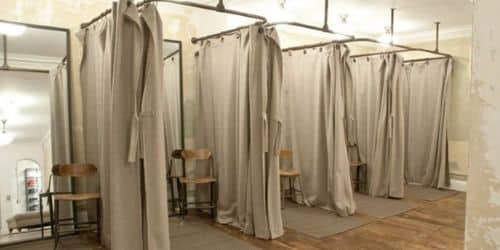Customers have traditionally worried about purchasing items online since their stuff might not fit. Many businesses have been attempting to create a solution to address customer issues while also delivering a more engaging shopping experience since the early 2010s. Innovative sizing solutions have emerged due to the recent decade’s rapid technical improvements. A portable virtual fitting room is quickly turning into a necessity for fashion businesses. In addition to resolving customers’ sizing problems, these solutions can also help brands achieve their inclusivity and sustainability goals while generating greater commercial performance.
What is a Virtual Fitting Room?
The digital equivalent of an in-store dressing room, a portable virtual fitting room lets shoppers digitally try on clothing to see how it could seem on their bodies and assess qualities like color, pattern, and style before making a purchase.
There are several virtual try-on options available nowadays. These frequently make use of augmented reality, computer vision, and artificial intelligence. However, not all virtual fitting technology yields the same outcomes or influences the consumer experience in the same way.
How Virtual Fitting Room Technology Works
The majority of virtual fitting rooms utilize augmented reality. A webcam is used in this instance to produce a 360-degree 3D model of a person’s physique. Artificial intelligence powers other virtual fitting rooms. Similar to augmented reality, AI employs algorithms and machine learning to produce full-body 3D models of the customer in front of the camera by measuring their physique.
Radiofrequency identification (RFID) is coupled with the 3D model produced by AI or AR. Another piece of equipment that scans the goods that customers bring into the portable virtual fitting room is this one.
The 3D model of the shopper is overlaid with the scanned goods thanks to virtual reality technology. In this manner, they can view how they appear when wearing a certain item without having to physically try it on. It’s simple to create a virtual try-before-you-buy program using this method.
To do this, some retailers are developing their software. Virtual fitting rooms can be made using iOS applications using ARKit, Apple’s augmented reality platform. Amazon is said to have also filed a patent for its own augmented reality-based “blended-reality” mirror.
Other significant companies in the market for portable virtual fitting rooms include:
- PITCOFiT (Shopify App)
- Style.me
- AstraFit
- 3DLOOK
- Klarna Virtual Shopping
This service is provided by several different businesses, and each has a varied price range and feature set. The prices some range from $129 to $549 each month, although many need interested firms to get in touch for a quote.
What are the Benefits of a Virtual Fitting Room?
Retailers can gain from implementing try-on technology in a variety of ways. Customers were 40% less likely to return an item if they utilized augmented reality software, such as a portable virtual fitting room, to try on apparel, according to Shopify.
#1. Increasing sales
Retailers may increase their clients’ buying confidence and encourage them to finish a purchase by assisting them in choosing the best size, fit, color, and style with the use of a portable virtual fitting room. Customers are also free to explore variations, personalize things to their tastes, and try on a large number of products in a short amount of time.
This entertaining experience can enhance consumer loyalty, which encourages recurrent purchases in addition to encouraging immediate sales. Unsurprisingly, merchants have used virtual try-on technology to double their sales and increase average order value by as much as 20%.
#2. Delivering a variety of experiences
Businesses can provide their customers with more inclusive and diverse purchasing experiences by using tailored virtual models. For instance, within the confines of a portable virtual fitting room, customers can select a digital model with a skin tone, size, and body type similar to their own.
A 3D virtual fitting solution powered by AI, however, enables shops to go much further in terms of customization and accessibility. With the use of these tools, clients may view how a product appears not just on a body model that they resemble, but also on a model that was built using specific information about their bodies. Retailers shouldn’t undervalue the possibility of profit from a highly tailored virtual try-on experience given the number of people who have been let down and left out by the lack of diversity and inclusivity in fashion.
#3. Lower return rates
The rising amount of returns is one of the main issues facing fashion businesses. Returns are inconvenient and expensive, particularly if you have a no-fee return policy. Shopify reports that too-small products account for 30% of all returns in the eCommerce industry, and too-large orders from customers account for 22% of all returns.
#4. Providing comfort for the client
Convenience is the cornerstone of a fantastic eCommerce experience and a major factor in the recent expansion of online purchasing. On the other side, cumbersome procedures may turn away customers. 97% of shoppers who shop online end their transactions owing to a lack of convenience, according to Smart Insights.
#5. Creation of omnichannel experiences
Virtual try-on technology can help marketers build the cohesive experience that customers want while also enhancing the eCommerce experience and bringing the convenience of internet buying to physical stores. Retailers introduced several safety measures amid the epidemic and turned to virtual changing rooms to take the place of the conventional fitting room experience.
What are the Limitations of Virtual Fitting Rooms?
#1. Customers still can’t physically touch items
Even if your online business offers a virtual fitting option, there’s still a chance that customers won’t purchase the products they’re trying on. Before making an online purchase, 57% of respondents indicated they like to see and touch the product. Virtual fitting rooms allow customers to view how the clothing will appear on them, but they are unable to touch the fabric.
#2. Distrust of virtual items looking the same
Have you ever purchased something online only to receive it in the mail looking completely different? Although virtual fitting room technology is sophisticated, some customers are still unconvinced that it can accurately represent products as they would seem in real life. They worry that when they try something on for the first time, it won’t appear the same because it may have been altered and placed on a real body.
#3. Technology can appear challenging.
Over the past ten years, virtual reality technology has only grown in popularity within the retail sector. Virtual fitting rooms are being used in physical stores and online stores by retailers including Adidas, ASOS, and Macy’s.
Virtual Fitting Room Examples
The following are a few examples of portable virtual fitting rooms:
#1. Parker Warby
A DTC retailer named Warby Parker only offers eyeglasses for purchase online. In a move to make shoppers feel more confident in their online purchases, it launched a virtual try-on function through its iOS app.
The functionality displays spectacles on a customer’s face using Apple’s ARKit and TrueDepth technologies. Before making a purchase decision, they receive a 3D model of the product to determine its suitability.
#2. Knix
Before the epidemic, Knix conducted the majority of its business through two showroom locations. The store took great delight in providing amazing customer experiences that assisted consumers in finding their ideal fit. Lockdowns, though, forced it to transfer its business online.
For online shoppers to receive the same level of service as those who visit the company’s physical stores, Knix designed a virtual fitting room. Thousands of virtual fits are now hosted on Knix’s website each month. To date, the vast majority of time slots have been reserved.
#3. Gucci
Gucci, a luxury brand, collaborated with Snapchat, a longtime leader in augmented reality, to develop its first four AR try-on shoes. It developed a virtual lens that superimposed the shoe’s digital representation onto a customer’s foot. Gucci reached 18.9 million Snapchat users with its AR campaign, which was coupled with a Shop Now button that led customers to its online store, and recorded a profitable return on advertising spend (ROAS).
#4. Charlotte Tilbury
Virtual fitting rooms can be used to engage in-store customers by businesses other than those in the fashion industry. In its flagship London store, the beauty firm Charlotte Tilbury built a virtual mirror. When customers approached the mirror, they might see one of ten well-known makeup looks applied to their features. They may email themselves a list of the makeup goods used along with a photo of the finished look.
Charlotte Tilbury discovered that users of the virtual mirrors were more likely to buy cosmetics in-store.
Reasons to Consider Virtual Fitting Room
Here are four arguments in favor of virtual changing rooms:
#1. Convenient, safe-fitting experiences.
At 65% and 54%, respectively, more than half of both women and men no longer feel secure trying on clothing in changing rooms. Retailers have implemented various safety measures in the majority of their brick-and-mortar stores in response to growing concerns about Covid-19 analogs, and they are looking at tech-driven dressing to quickly replace the fitting room experience, which used to be the key selling feature of physical stores.
#2. Boost conversion rates.
In-store shopping was favored by 62% of consumers as of 2017 because it allows them to see, touch, feel, and try out products. Retailers may assist customers in determining size, fit, and style through virtual changing rooms, empowering them to make wise purchasing decisions. Additionally, by utilizing virtual models, shops can finally provide their customers with truly inclusive and diverse shopping experiences. In virtual dressing rooms, customers can choose a digital model with a similar skin tone, size, and body shape.
#3. Make customers out of casual browsers.
88% of consumers conduct internet research before making a purchase, and 49% of shoppers claim that smartphones have affected the way they shop. Retailers will be able to turn these “casual browsers” into fashion e-commerce if they can create individualized, welcoming, and interesting dressing room experiences. (Be aware that 66% of customers won’t purchase from a website if they believe the information doesn’t relate to their particular interests.)
#4. Increase retention and loyalty with virtual changing rooms.
According to an SAP survey, 39% of merchants cited the “ability to turn customer data into intelligent and actionable insight” as one of their top challenges. Retailers have experienced an increase in their average order value of over 23% because of AI-powered style, according to internal studies from my company. With the use of virtual changing rooms, fashion merchants may get a wealth of consumer information that will help them comprehend their customers.
What Does Fitting Room Mean?
A section of a store where buyers can try on clothing to determine fit before purchasing it.
Is It a Dressing Room or a Fitting Room?
In a department shop, for example, customers can try on clothing in a room known as a fitting room or dressing room. Men and women may have their changing areas, or there may be a non-gender-specific open area with individual cubicles or stalls, like in public restrooms for both sexes.
What Makes a Good Fitting Room?
Tips & ideas for fitting rooms:
- Make sure there is ample space.
- Include chairs in a changing area.
- Use neutral light.
- Establish privacy.
- Cut back on decorative fixtures.
- Organize your dressing rooms.
- Put up mirrors.
- Staff your fitting rooms.
What Are the 5 Standards for Good Fitting?
The ease, line, grain, set, and balance of a garment are the elements that determine whether it fits well or not. They are also connected and are known as the standards for a good fit.
Do You Leave Clothes in the Fitting Room?
It doesn’t matter if they take it back out or leave it in the dressing room. Everything is fine as long as the clothing is put back on the hanger.
Should I Flip My Clothes Inside Out?
To protect the fabric throughout the wash cycle and keep your garments looking new for a long time, turn your clothing inside out before washing it.
How Important Are Fitting Clothes?
The impact that well-fitted clothing makes on your appearance is enormous. When we talk about well-fitted clothing, we mean items that follow the contours of your body, give you room to breathe and move, and don’t add bulk to your frame.
Conclusion
Giving customers the virtual shopping experiences they want is essential for success in modern retail. The days of going into a store, waiting in line for a changing area, and then changing clothing are long gone. No matter where a shopper is perusing, a portable virtual fitting room provides the convenience that they desire. They’ll increase customer interaction, lower return rates, and enhance online sales.
Related Articles
- Men’s Clothing Business Casual: Best business casual for men (+tips)
- Window Dressing: Best 2023 Window Dressing Ideas for any Business (+ All you need)
- Best business to start with little money right now (+ all you need to start)
- TOP BUSINESS TRENDS TO LOOK OUT FOR IN 2023-2024






